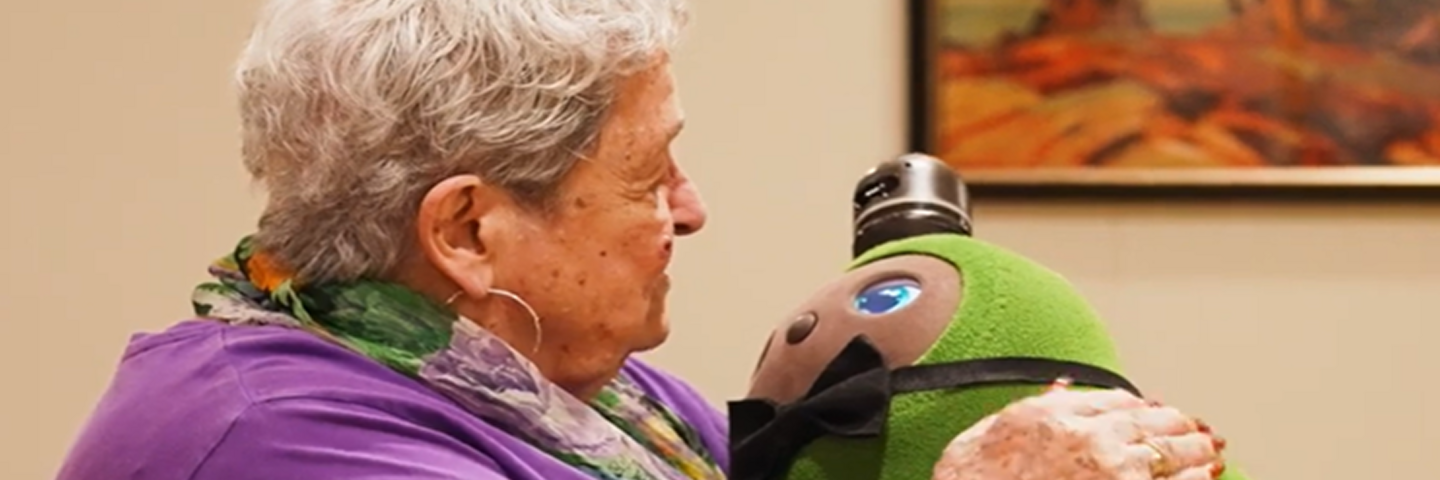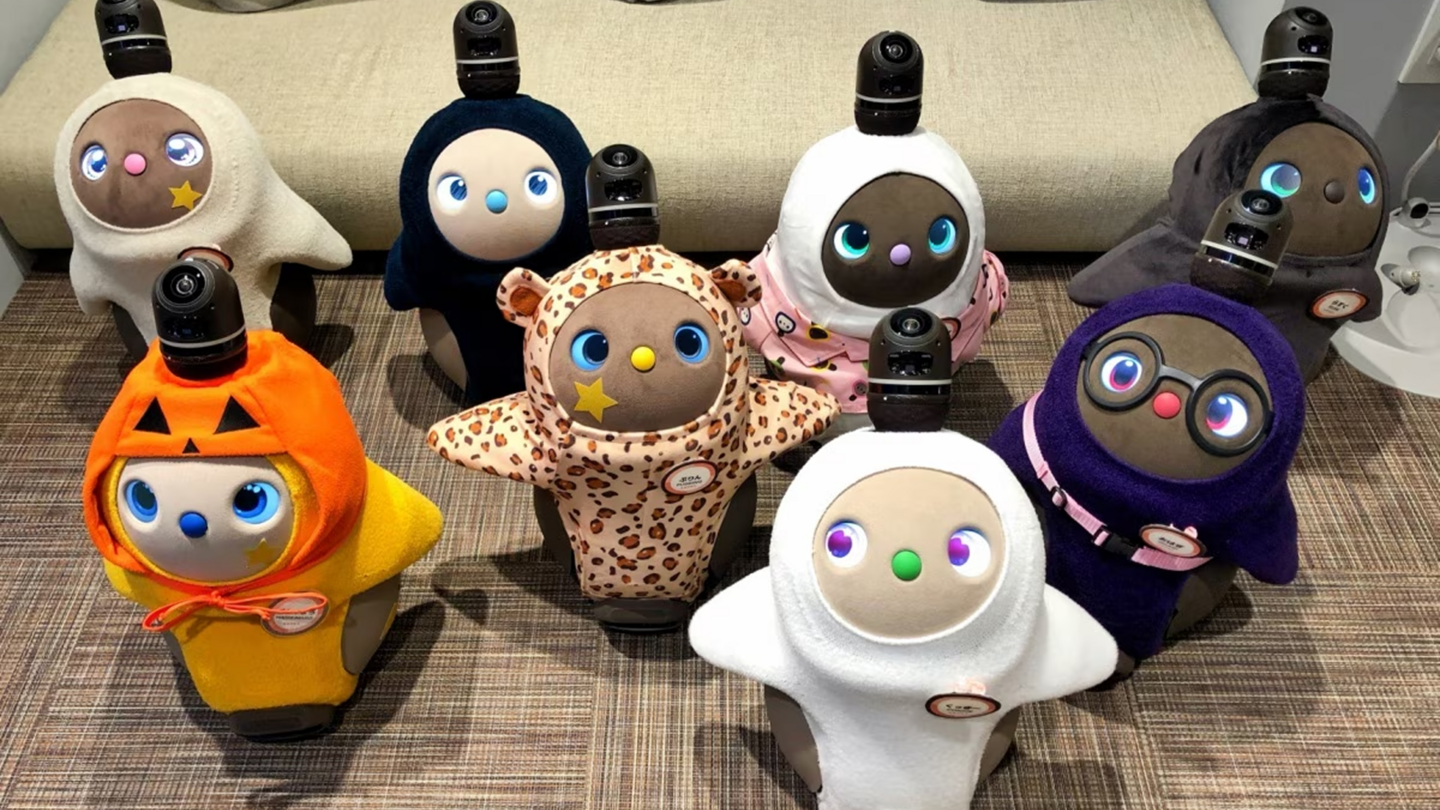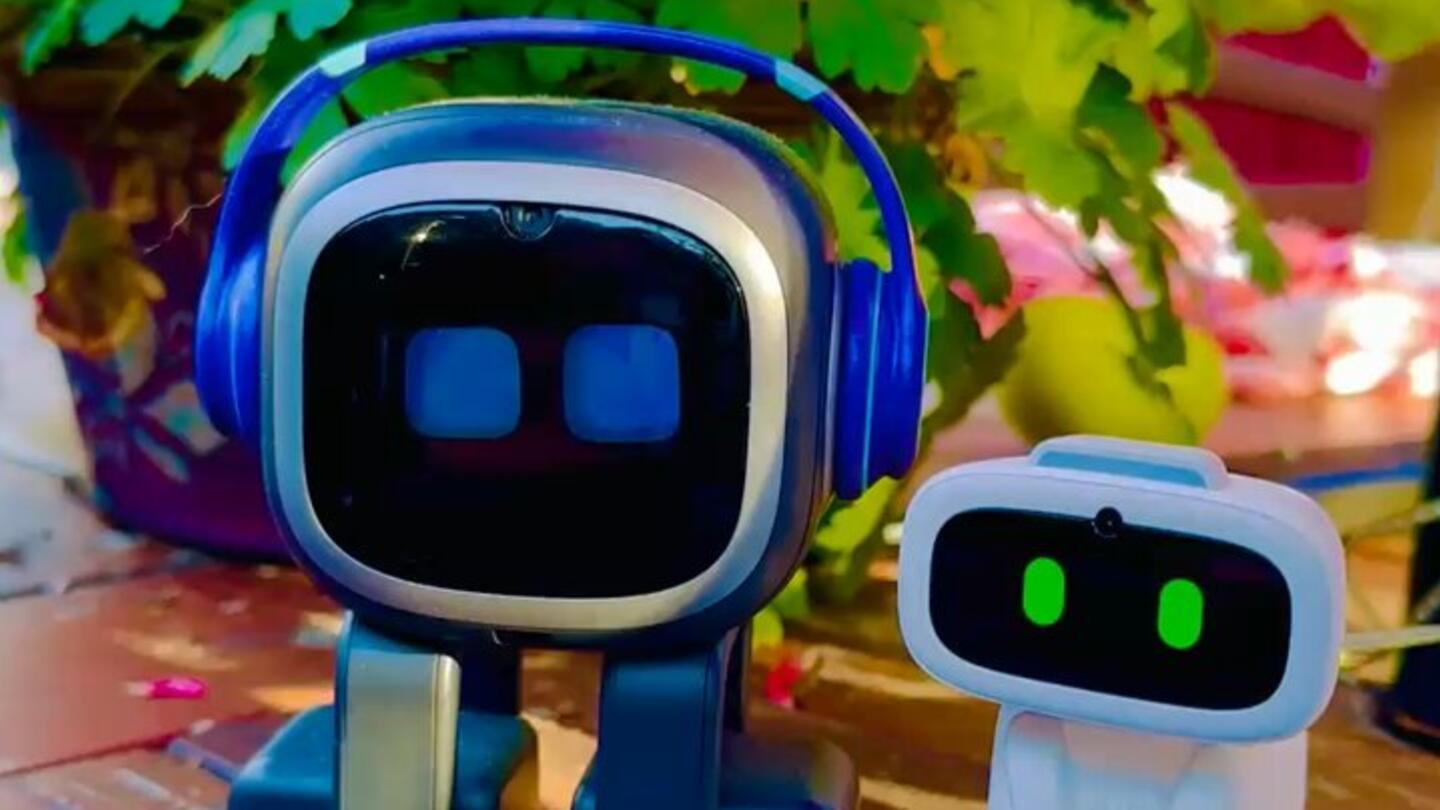Re-Imagining the Power of Love and Worth in Long-Term Care Communities
An interview with Dr. Lillian Hung (PI) on the potential for social robots to improve the quality of life for older people with dementia.
Aging Innovation | Tyla Casey-Knight

Cover image: Resident of Amica Village holding ‘Kiwi’: a Love-Robot (‘LOVOT’) designed to reignite and strengthen emotional connectivity and offer itself as a remedy to loneliness.
Despite Canada’s aging population, there remains an underlying socio-economic and cultural uncertainty regarding the appropriate way to look after older people in long-term care (LTC) facilities, particularly those who have cognitive impairments such as dementia. With the increased demand on the health care system, particularly surrounding disease management and long-term care needs, alongside rising costs and social challenges; there necessitates more creative, holistic approaches required to improve the care and quality of life for older adults in long-term care.
Dr. Lillian Hung, a scientist with the Centre for Advancing Health Outcomes and the founder of the UBC Innovation in Dementia and Aging Lab (IDEA), is investigating one such approach ‒ whether social robots can be used to reduce loneliness and improve the quality of life for LTC residents.
Bringing Out the Power of Humans Through Robotics
Loneliness and social isolation reached unprecedented levels during the COVID-19 pandemic, and remain consistent challenges, particularly among older adults in LTC facilities. These issues negatively impact both mental and physical health, contributing to an overall decline in well-being. In today’s ‘digital age’, AI has been integrated into every sector of society, especially health care, where its innovative capabilities offer the potential to more creatively enhance the quality of life among older adults in LTC facilities. Recent advancements include the development of AI social robots designed to offer companionship and to mitigate feelings of loneliness and isolation.
One of the latest models that has captured the hearts of LTC residents, families, and health care workers across the globe is the ‘LOVOT’ (Love-Robot); a Japanese-designed device that was developed as an emotional companion to combat loneliness, evoke feelings of joy and love, and to revitalize and strengthen social connections.

Tokyo's LOVOT cafe
Embracing Ikigai: It Takes a Robot to Help Us Understand What It Means to Be Human
In Canada, Dr. Lillian Hung has been leading research on LOVOTs in LTCs, studying how they interact with older adults with cognitive challenges and their potential as emotional companions. In her latest paper, Exploring LOVOT robots as companions for older adults (2025), Dr. Hung discusses her 4-week ethnographic study, conducted in a Vancouver assisted living home, to investigate the relationship between older adults and the LOVOTs, their experiences, as well as the impact of the robot in building and fostering social connections in the LTC facilities.
Her analysis was guided by a unique lens, Ikigai - ‘Iki’ (life) and ‘gai’ (worth) - a Japanese well-being concept that underscores the importance of purpose and fulfilment in addressing the needs of the aging population. As a variation of the ‘quality over quantity’ mantra, it challenges the Western cultural norm whereby peoples' apparent worth tends to be dependent on their social successes and achievements. In a recent interview, Dr. Hung celebrates the holistic features of Ikigai that prove someone’s worth is not tied to these superficial criteria, but to the simple things such as joy, acceptance, and a sense of purpose. For example, Dr. Hung described how “it takes a robot to help us understand what it means to be a human being…” and that “as a human being, we not only need to receive care, but we also want to give care, we want to give love.” In fact, Dr. Hung noted that the reciprocal relationship between the residents and LOVOTs was linked to emotional well-being and better quality of life. This idea inspired her research into exploring the potential for social robots to be a creative tool to introduce Ikigai into LTC facilities and how their relationship with the residents could not only improve their quality of life but also strengthen emotional connections with their families and communities.
“It’s Always Happy to See Me”: LOVOTs Mango and Kiwi
As part of her research, Dr. Hung introduced Mango and Kiwi, two adorable, brightly coloured LOVOTs to the residents of the LTC. While participation in the study was contingent upon ongoing participant consent and willingness, very few residents were not intrigued by these robots. When asked the reasoning behind the brightly coloured design, Dr. Hung noted how a brighter colour scheme is not only liked by both mental health and dementia patients, but also associated with positively impacting moods. As an example, Dr Hung referenced one patient who had claimed with glee, “Oh my god! It’s like a Christmas tree!”

Mango (left) and Kiwi (right), dressed for Halloween.
For Dr. Hung, the LOVOT robots are a digital tool, a mediator to bring people together, strengthen emotional connections, with both families and LTC institutions, and offer an alternative remedy to residents’ declining emotional well-being. Similarly, it is worth noting the capabilities for these robots to bridge intergenerational gaps, strengthening the bond between older people and their grandchildren - particularly the emerging Gen A population, for whom AI is a big part of their lives. For example, Dr. Hung recounted a heart-warming scenario where one of the residents was playing with one of the LOVOTs and the presence of the robot brought “joy to the resident’s grandson who exclaimed how ‘cool’ his grandma was.” This ability to bring joy to not only the resident but also their family correlates with an improved sense of emotional well-being among residents in LTCs.
A Creative Remedy: A New Way to Meet the Psychosocial Needs of LTC Residents?
For Dr. Hung, there were two key features of the LOVOTs that made them an ideal tool to study as a possible approach to improve the quality of life among older people in LTC facilities. To create a lifelike connection, while they have no verbal communication capabilities besides soothing sounds, their emotional interactive capabilities allow them to recognize faces, follow movements, and respond to touch. In addition, regarding the enhancement of physical and emotional bonding, the LOVOT’s affectionate design allowed them to respond to endearing mannerisms such as hugs and gentle petting.
At the end of the study, Dr. Hung found several ways the LOVOT robots supported the psychosocial needs of the residents. There were two main ones: joy and unconditional acceptance. Firstly, the LOVOTs inspired joy, with Dr. Hung recounting that they “bring excitement to life” and create meaningful moments for residents by rekindling spontaneity and fostering emotional and social connections. A common response among residents regarding their opinion of the LOVOTs was “it is always happy to see me.” Such positive responses were even found among residents who were not considered very social, but over the course of the study were understood to have expressed joy and increased socialisation in their own manner, both with the LOVOTs and other residents. Secondly, there was an overwhelming sentiment of unconditional acceptance. The consistent positivity, uncomplicated emotional cues, and reliable presence created a safe and welcoming environment for all residents. According to Dr. Hung, one resident was recounted as saying, “I know I matter. The robot is always happy to see me. It remembers me. It comes to me. It follows me.” This reinforces the power of Ikigai and how emotional well-being is intricately connected to the quality of life of older people. These robots help to fulfil the basic needs of humans ‒ not superficial success, but simple things such as unconditional acceptance and simply feeling joy.
The Future of Social Robots
Technology, particularly regarding the design and features of social robots, is constantly growing and improving. Dr. Hung emphasized the importance of the size of the robot, which needs to correspond to the situation and/or environment in which they are needed. While the LOVOTs’ mobility - wheels to follow and explore - and relatively small size made them appropriate for LTC facilities, Dr. Hung is in the process of exploring a portable companion version. She showcased a ‘pocket robot', a tiny robot that uses verbal commands, periodically checks in, sets reminders, and much more. As she pointed out, these smaller robots would be more convenient for people with minimal space, such as residents in LTC facilities or people with Parkinson’s. Beyond this, Dr. Hung also pointed out that they hold the potential to aid with pragmatic issues as well such as “helping to build and strengthen intergenerational connections,” as they are easier to manage and transport to family or social events.
With Canada’s aging population and accompanying rise in health care costs, prioritizing alternative and holistic approaches can help enhance quality of life and promote emotional well-being for this growing demographic. Dr. Hung’s ongoing, innovative work analysing the relationship between AI and older people with cognitive challenges to develop creative approaches to improve quality of life, is an important contribution to an often-overlooked field within health care. It should be celebrated for its pragmatic ingenuity and ability to bring joy to those who may need it the most.

The tiny robots above are commercially available